In this new raw, unfiltered observational wildlife series, an elite camera team capture the dramatic lives of African big cats in the breath-taking Okavango Delta, Botswana. Wildlife Cinematographers Gordon Buchanan, Vianet Djenguet and Anna Dimitriadis join forces with the Natural History Film Unit, Botswana led by Brad Bestelink and his local camera team.
Following individual lions, cheetahs and leopards for six months, over two extreme seasons, this documentary shows their battle to survive in an increasingly challenging world. From unprecedented wildfire to flood and extreme drought, the cats and camera crew are tested to their limits. With extraordinary, unparalleled access, in an area unvisited by tourists, and the opportunity to film from the ground, the air and through the night, the Big Cat 24/7 team work together to follow the cats’ lives around the clock.
A linear story across six crucial months, the camera team form unique bonds with the cats, and each other. Each episode follows a pivotal point in our cats’ lives, ending on a cliff-hanger. A revolution in low light camera technology means the series showcases previously unseen behaviour at night; cutting-edge drones keep track of the big cat’s movements like never before, and combining the raw endeavour of an expedition with premium natural history footage gives the show a contemporary new approach.
Big Cats 24/7, a 6×60’ for ���˿��� Two, iPlayer and PBS is made by ���˿��� Studios Natural History Unit and co-produced by PBS. It was commissioned by Jack Bootle, Head of Commissioning, Specialist Factual. The Executive Producers are Roger Webb and Tom Jarvis, the Series Producer is Rowan Crawford and the Production Manager is Gillian Goodlet. The Commissioning Editor is Head of Natural History Sreya Biswas. Sylvia Bugg is Editorial Consultant for PBS. Diana El-Osta is the Executive in Charge for PBS.
EC5
Watch Big Cats 24/7 on ���˿��� iPlayer and ���˿��� Two from Sunday 25 August at 8pm.
Meet the Cats
Lions
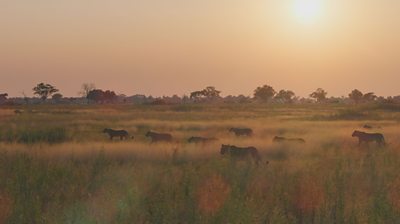
The Xudum Pride
- 2 dominant males
- 2 sub-adult males
- 18 females (estimated)
- 14 cubs – from 6 mothers
Total: 39 and counting... (as of end Oct 2023)
The Xudum Pride is one of the largest prides the Delta has ever seen. The pride is led by a coalition of two males – Madumo and Big Toe – who have been in power now for just over five years. Coalitions tend to survive around two years in most places, but our males have held on for much longer. Perhaps because of the geography and seasonal flood that help isolate their territories? The pride is thriving in this unspoilt wilderness. Food is plentiful and the cats seem happy.
During the series (2023), the fire and the delayed arrival of the flood alters the natural barriers of the landscape and opens the pride’s territory to incursions from intruding male lions. The pride is exposed to increasing pressure from multiple coalitions of intruder males throughout the year. The Xudum Pride’s territory is a lion’s paradise, and with so many available females in the group, it’s a highly prized target for incoming males to take over. The eventual arrival of the flood seems to provide some respite from these pressures. The question remains though; how long can this number of lions sustain themselves as one group? As the flood dries up again, the game leaves, and the cubs start to demand meat, the pride may be forced to split to find resources elsewhere.
NB. All ages and dates given are as of Oct 2023.
The Boys: Dominant Pride Males
Madumo – ma-doo-mow – "to roar"

The ‘poster boy’ with the brains and muscle to back it up
Age: approximately 10 years
Madumo is bigger and heavier set than his coalition partner, Big Toe. He has been part of the ruling coalition for 5+ years now. In 2022 the pride had just one cub, but in 2023 he and Big Toe were prolific breeders, with the lionesses giving birth to 16 cubs that year. Madumo tends to hold back and let Big Toe go first into battle with intruders or do the heavy lifting in scuffles with family members. Madumo is the brains of the operation, while Big Toe is the grafter. However, when required Madumo will step up and has the muscle to be a powerful and commanding leader. He protects his pride, and the younger males are all submissive to him.
He and Big Toe are extremely close and affectionate to one another. They are most likely to be brothers from the same cohort of cubs. They continue to make a strong and formidable partnership and still stand uncontested as the leaders of this pride. Madumo sustains a leg injury, likely from fighting off a pair of intruding male lions in the series, but recovers quickly. But with intruders making repeated and bold forays into their territory, their dominance continues to be tested.
Big Toe – translates as Lenaotuna, len-ow-toon-aa
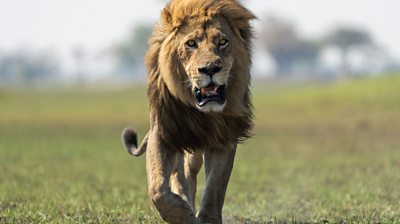
We use Big Toe because he has one long toe which makes following his tracks easy.
The ‘grafter’ who does the dirty work.
Age: approximately 10 years
Big Toe is slightly leaner and more wiry than Madumo, but no less formidable. His face is the more handsome of two. He’s usually the one to get into a scuffle first and isn’t afraid to assert the coalition’s dominance with intruders, or the younger males in the pride. Big Toe has shown tolerance, and even some playfulness towards the eldest group of cubs in the pride, which is not commonly seen. But he’s also been seen chasing the cubs and lionesses off a meal to keep it for himself, and more cracks may appear as new and growing cubs put food pressure on the pride.
Sub-Adult Males
Nkgonne – en-kon-eh – "older sibling"

The Disperser
Age: 2-3 years
Nkgonne is the eldest of the sub-adult males and visibly the biggest of the four young males in the pride. He is closely bonded to one of the younger sub-adult males, Colin, and the two make a comical pair and look likely to become future coalition partners. They are unlikely to be full brothers, but almost certainly related.
Nkgonne is coming of age and getting too big, handsome and frisky with the females (his sisters, aunties, and mum) for his own good. He was even seen challenging the dominant males before filming began. As a result his days in the pride are numbered and we follow the early stages of this dispersal in episode 3 of the series. Nkgonne becomes more and more distant from the main pride and by the end of filming is rarely seen with any of the others except Colin. These are all signs he’s moving / being pushed out.
During filming Dr Robynne Kotze tracked Nkgonne and Colin 15km away from the heart of the pride territory after they ran away from a pair of intruder males and left a pride lioness to fend for herself. This is the path of male lions – they stay with their family until 2-3 years old and then when ready to mate, and big enough to take on their own pride they are pushed out, dispersing into new territories…or they try to overthrow their fathers. Given the sheer size of the Xudum Pride it is not at all impossible that a split in the pride could see Nkgonne become the leader of his own group. But he’ll need a coalition partner, and Colin looks like a strong contender for this position.
Colin (M049)

The only collared lion in the pride, The Mummy’s Boy
Age: 2-2.5 years
Colin is the second oldest sub-adult male and closely bonded to Nkgonne. He is the only collared male in the pride and is being studied by Dr Robynne Kotze as part of Oxford University Wildlife Conservation Research Unit (WildCru) predator study, which follows dispersal patterns in young male lions. Colin is on a similar path to Nkgonne and will be forced to leave the pride.
He is deeply loyal to Nkgonne and sticks with him, trying to impress and follow him, but is still drawn back to the main family group from time to time – and when required he is still taking part in hunts with the other females. He will also leave Nkgonne for short spells to feed with the females, and then return. He is facing the hard choice of sticking with Nkgonne as he moves further out and eventually leaves, or staying with the safety and security of the pride for longer.
The Girls
“The Matriarchs” (mother cohort 1)
Magogo – m’go-go – “old lady”
The Matriarch
Age: 10 years
Magogo is possibly one of the oldest females in the pride. She’s an experienced and wise lioness who has successfully reared cubs before. She is the mother to the eldest cub, Mathata, who could be a future pride male. She is closely bonded to Mmakgosi and Nosi, and together the three have formed a close unit to alloparent their cubs who are of a similar age. Magogo and Mmakgosi arguably have a closer bond together than with Nosi. Both are older than Nosi, and they had partnered up together earlier in 2023 before Nosi joined with her cubs around June, 2023.
Mmakgosi – ma-k’os-ee – "mother power"
The Second In Command
Age: 10 years
Mmakgosi is another older female in the pride and similarly powerful and influential as Magogo. However, lionesses in prides are all equal in the hierarchy so no one is dominant. Mmakgosi currently has a litter of two cubs – a boy and a girl – and is working as a team with the other two lionesses to collective raise a group of 5 cubs of a similar age. As above, Mmakgosi is closely bonded with Magogo, and slightly less so with Nosi. The three are a formidable group.
Nosi – naw-see – “loner”
The Huntress
Age: 6
Nosi is younger than Magogo and Mmakgosi. She is the mother of the two youngest of the eldest generation of cubs. We think they are both female. She lost a third cub during filming in July. She had her cubs slightly later than the other two above, and joined their group after a significant period going it alone whilst her tiny cubs were still in the den.
During this time she proved to be a strong hunter, able to catch and kill prey alone to sustain herself and her cubs, but once they were ready to leave the den and come out into the open she had to find some support. This is when she joined up with Magogo and Mmakgosi to alloparent and creche their cubs together, showing how vital it is to be part of a pride. Having cubs at the same time as your peers allows the females to protect the cubs together and share parental responsibilities, one looking after rowdy, growing cubs, whilst the others hunt, and then all sharing food. Nosi is the instigator in the group of three. She is always looking out for prey and will be the first of the three to get up on her feet and start making the move to hunt.
New Mums
Matho – ma-toe – "crazy eyes"
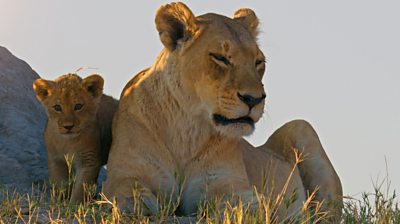
Age: 10 years
Matho gives birth to 3 cubs in late July 2023. She has difficulty finding a suitable creche to alloparent her cubs and allow her to hunt. This is because her cubs are significantly younger than the older cohort of 5. It’s suspected she is around the same age as Magogo and had a cub around the same time as her earlier in the year that died. In her struggle to find other females to help her raise her triplets, she loses one of her cubs.
Naledi – na-le-dee – "star"

Age: 6 years
After two encounters with Gordon we lost her until she resurfaced around 10th September and led us to 2 tiny cubs. We still don’t know a lot about her character, but we think she initially had 3 cubs and lost one very early on.
Tsebe – t’se-bay – "ear"
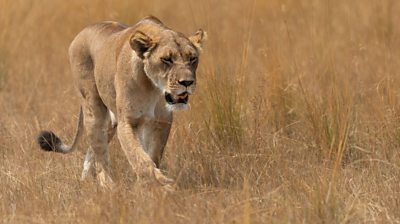
Age: 5 years
In Sept 2023, Tsebe gives birth to a huge litter of 5 cubs! This is really unusual and potentially a sign of the strength of the pride. These are the youngest cubs in the pride. Tsebe has a notch in one of her ears, hence her name. Tsebe teams up with Naledi and Matho to form a creche in late Sept / early Oct 2023. But despite the support from other females, the team follows Tsebe as she frequently hunts alone, suggesting she was trying to find additional food to help sustain her and her 5 cubs. A litter this size is unusual and creates a huge amount of pressure on the mother.
The Cubs
The Original Cubs (Magogo, Mmkgosi & Nosi’s)
Mathata – ma-tah-ta – "trouble"
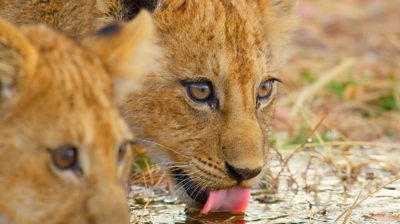
A Future Pride Male
Age: 8 months
Mathata is the largest, boldest and most boisterous of the five older ‘original’ cubs being raised together. He is the loveable rogue, and son of Magogo. He is significantly larger than the other 4 cubs around his age and growing rapidly. He’s confident and keen to investigate new things. Mathata shows all the signs of becoming a future pride male – but he can be reckless and overstep his age and experience, also leading the other cubs into danger.
The Intruders
Tshenyo Brothers
These two younger looking males are around 4-5 years old and are spotted twice in the series. The first time after the wildfire when they are swiftly seen off by BT&M. The second time they appear they chase off Sub-Adults Colin and Nkgonne and face off against the mums and cubs when BT&M are nowhere to be seen.
Leopards
The Girls
Xudum – koo-d’m – "tortoise" and the name of the island where we are based

The Superstar Aerial Huntress Determined To Be A Mum
Age: 5 years
Despite several valiant attempts, Xudum is yet to successfully rear cubs. She has lost at least one, possibly two litters, but is now reaching an age where she should have the experience to raise at least one cub to adulthood. She is the resident female in the area we are working in and her territory surrounds our film camp.
She is well habituated to Brad/Tristen/the trucks, and will tolerate being closely followed and observed for long periods of time. She regularly visits the film camp, wandering through at night. She is a pretty female, quite small, but powerful and brave. She is Brad’s favourite leopard in the area and he has known her since she was a cub.
We follow Xudum perfecting her skill as a tree jumper, and we are now seeing territorial pressures coming in on her from surrounding leopards. Her territory is perfect leopard country. There are good denning sites; trees to jump from and long grass to ambush prey from; and there is access to water. This makes it desirable to other leopards too.
Bontsho – bont-so – "the dark one"
The Nightmare Neighbour. Age: 7 years
Bontsho is Xudum’s neighbour to the northeast. Bonthso and Xudum don’t get along at all! Bontsho is particularly aggressive towards Xudum and is filmed chasing her out of her territory when Xudum is patrolling, potentially looking for a mate. Bontsho wins the battle and Xudum is sent packing back to her own territory – fortunately uninjured. Bontsho has a ‘femme fatale’ vibe about her and needs to approached with real patience and care.
The Boys
Mosweu – mos-way-oo – "the pale one"
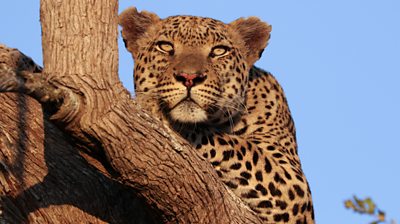
The Kingpin
Age: 6 years
Mosweu is the dominant male leopard in the Xudum area. He’s a brute and a fighter, as evidenced by the many notches in his ears. He is a large, pale coloured, handsome leopard. Powerful and relaxed. He is filmed following Xudum and another male as they are mating in his territory in July 2023.
Metsi – "water"
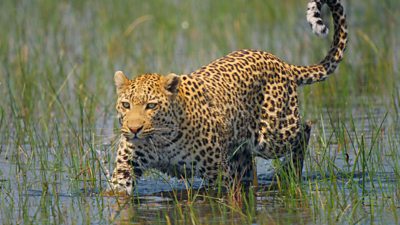
The Young Upstart, With Brains Over Brawn
Age: 5 years
Metsi is a young male leopard who has been seen boldly exploring the area multiple times. He needs to establish his own territory, but he is not big or dominant enough to do so yet, especially with so many leopard males in the area.
He is filmed stalking through the water in broad daylight, making no effort to conceal himself and is set up as a potential danger to Xudum who is pregnant at the time. He is also filmed at night in a parallel run showdown with a larger unknown male who has made a kill.
Cheetah
The Girls
Pobe – "pawb-eh" – 'pobe' = 'dimple'
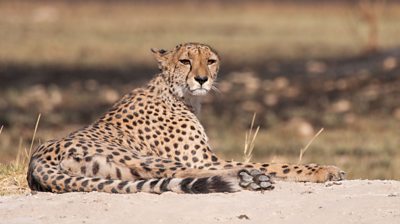
Pobe is named after the grey, dimple-shaped mark on her cheek
The Streetwise Cheetah.
Age: 7 Years
Pobe is the most commonly seen female cheetah in the Xudum area. Wellknown to the NHFU team, her territory directly overlaps that of the lions and she has managed to survive alongside them for years. She is extremely illusive, with a knack for avoiding the Xudum pride lions.
But she’s not shy – she’s a smart and experienced female cheetah who has successfully reared at least one female cub to adulthood. It’s extremely impressive to have raised a cub in the Xudum area because of the density of lions, and testament to what an impressive cheetah Pobe is. Pobe is also a resilient and persistent cheetah. We see her fail multiple hunts but never gives up and eventually wins her prize in spectacular fashion.
Neelo (F002) – “nee-low”, Pobe’s daughter
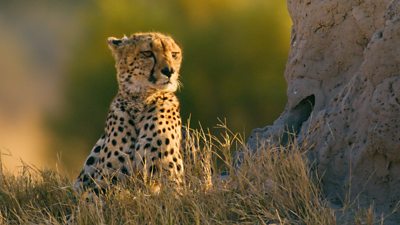
Age: 2 years
Neelo is Pobe’s daughter. Pobe successfully raised Neelo to adulthood in 2022, a very impressive feat in an area with as many lions as Xudum Island. Neelo has inherited her mother’s incredible hunting skills, and apparently also her prowess for living alongside lions.
Lesego – "less-eh-gho" – 7 years
Supermum
Age: 6 years
Lesego is filmed with her three 18-month-old cubs (two males, one female). At this age, they are the same size as her and very close to leaving their mother to calve out a living by themselves. Raising a family of four is a ridiculously strong feat for a cheetah in the Okavango. She is a very shy cheetah and completely unhabituated to filming vehicles. She was found 10s of kilometres to the south of Xudum Island, away from the high lion density – no doubt, this is key to her success.
The Boys
Sepoko – "spock-oh"
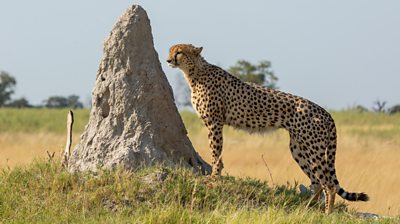
‘Sepoko’ means ‘ghost’ in Setswana, and fittingly Sepoko often appears and disappears like a ghost
The ghost
Age: 5 years
Sepoko is most likely a transient male cheetah passing through the Xudum Island area. He is filmed twice by Anna and Greg across a few days directly before the wild fire, and then again later by Anna and Rea after the flood arrives. He is a big, impressive male cheetah, in good condition and looks like he has made a kill in the area the last time we see him.
He is shy and easily spooked and eventually chased off by some baboons; but he’s somehow managing to eke out a living amidst the enormous Xudum Pride, which is testimony to his ‘ghost’ like character. We see him doing a lot of scent marking, and even climbing a tree, which is unusual for cheetahs who don’t have retractable claws, making it harder for them to grip and climb.
Mushi – "mush-ee"; 'Mosimane' means 'young boy'
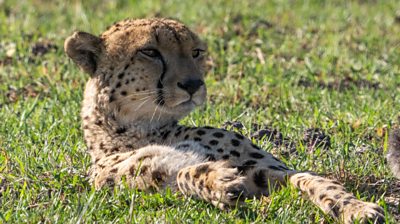
Age: 2 years
Mushi is a young, transient male we encounter passing through Xudum Island. Smaller and slighter than Sepoko, he is younger and less experienced – yet based on his ability to hunt, he seems to have a bright future ahead of him.
Meet the Big Cats 24/7 team
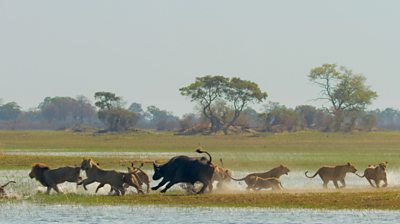
Vianet Djenguet (Wildlife Cinematographer)

What made you want to be part of this series?
For me, filming Lions was a childhood dream. I remember hearing stories of the lions still present across the savannahs of my home country; the Congo. Lions are emblematic to Africa, a symbol of power and pride. I was so happy to work on this series, so I can be part of giving this iconic African species a voice. I believe that the lion’s iconic status can obscure people’s perception of its plight for survival.
Tell us about your personal passion for the big cats explored throughout the episodes.
My personal passion lies in the structure of the pride. The bond between the females and the cubs.
The dynamics of the family. This is so unique to lions, since all other big cats are mainly lone species. With lions, it is fascinating to observe their relationships. Their loyalty, their hunting tactics, their roles within the pride. They are raw, beautiful, powerful and savage all at once.
Tell us a bit about your background, how did you get into wildlife filmmaking?
When studying at film school we were mainly trained to tell human stories, and it was Bristol that opened the door to me to progress into stories of animals. Being from the Congo, a place full of wildlife species in a vast wilderness, it was a natural move. Conservation and wild species are inspiring as this is the natural beauty on the planet that needs understanding and protecting so we can maintain the balance the planet needs.
What challenges did you face whilst filming this series?
The challenges I faced when filming this series were processing the emotions getting to know a pride brings. I realised how vulnerable these lions are, despite how they have been portrayed for centuries. I have to say, it is hard to watch predators killing their prey and there are mixed emotions when a hunt is in action. But hunts are not always successful and a pride has many mouths to feed and other hungry mouths are always nearby too. Survival of the cubs is down to every hunt and the protection of the females, as well as the male maintaining the territory. It was challenging to see the risks and dangers these animals live.
What was the most standout or memorable sequence for you in this series?
The most memorable sequence in the series for me was when females faced off two intruding males who were approaching their cubs. This is a dangerous situation, as cubs will be killed by intruding males. Thankfully that didn’t happen as the Females stood strong and bravely protected their cubs. It was intense and brings home the reality of how tough it is for lions to survive.
Did you learn anything new about Botswana and the big cats you filmed that you didn’t know before being involved in the series?
I Learnt a lot of new aspects about lions in this part of Botswana. These lions are so adapted to the Okavango Delta and its unique ecosystem. The flooding and drying of the delta means every species has adapted. It was Fascinating to see these lions so adapted to climbing trees and using them to their advantage.
What do you believe is so captivating about this region?
Okavango Delta is a remarkable landmark that brings such abundance of life and with it a concentration of species in competition. Then it transforms to a harsh dry environment where survival is challenged until the next season of abundance.
Do you have a favourite big cat from the series and why?
I only spent time with the lions, specifically mothers and cub, I loved them all. However Matata the oldest cub really caught my attention, gave me a smile every time I saw him, he was just full of energy and reminded me my own son.
Which is your favourite big cat story from the series?
Again, I only spent time filming lions and the dynamics around them which made me fall in love with them.
What do you hope viewers will take away from watching Big Cats 24/7?
I hope the Viewers of Big cats 24/7 will understand that lions need the attention of the world, and consider how they can help protect them. Lion populations have plummeted in the last two decades from around 200,000 to 20,000 individuals across Eastern and Southern Africa. I hope it will inspire people to get involved and help the people who are tirelessly working in conservation.
Gordon Buchanan (Wildlife Cinematographer)
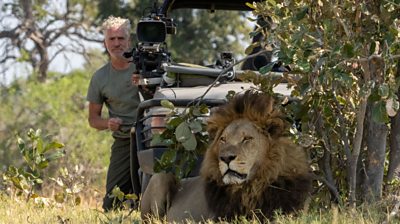
What can you tell us about the series?/ What is the series about?
The series follows the lives of three big cat families, Lions, Leopards and Cheetahs in one of the world last true wildernesses, The Okavango delta. We capture intimate and mind blowing behaviour of these animal icons round the clock in this challenging but unimaginably beautiful hidden part of Africa.
What made you want to be part of this series?
I have filmed big cats all over the world for the past 30 years - it has become an obsession. I worked on the Big Cat Diary series for the ���˿��� back in the early 2000’s, so the opportunity to follow Lions in this Big Cat paradise was a dream come true and a chance to deepen my obsession!
Tell us about your personal passion for the big cats explored throughout the episodes
Lions may be big, bold and on occasions very loud - but following their lives around the clock is incredibly tough. They can sleep for twelve hours straight and then move fast and far on their territorial patrols. I am really proud of how we have been able to tell their story. From epic battles with invading males to intimate moments with tiny cubs.
Tell us a bit about your background, how did you get into wildlife filmmaking?
When I was 17 I was working in a restaurant for a lady called Anne Gordon. Annes husband was a renowned wildlife filmmaker. I thought that sounded like the best job in the world. I initially went to Nick for advice. We got on really well and he must have seen something in me that I was unaware of. He offered me the job of camera assistant in Sierra Leone for a year and a half long project. I packed in school and off I went!
What challenges did you face whilst filming this series?
Fatigue and lack of sleep comes with the territory and a daily challenge. But immense wildfires were a huge threat and very nearly stopped our project in its tracks. Digging four wheel drive vehicles out of swamps in the dead of night when there are marauding and aquatic lions around is a task you learn to complete very quickly.
What was the most standout or memorable sequence for you in this series?
Hands down highlight for me was filming lions adopting a crocodile style of hunting of a semi aquatic antelope species by wading into lakes on pitch black moonless nights.
Did you learn anything new about Botswana and the big cats you filmed that you didn’t know before being involved in the series?
No two big cats are the same - their lives are one big power struggle between their own species and the animals they live along side. Not two days are the same. There is more drama here than in Game Of Thrones.
What do you believe is so captivating about this region?
This is a hidden corner of Africa. A place where animals thrive and the human race is largely forgotten. The Okavango is a miracle in itself. A dry austere desert turns into a watery paradise every year with the arrival of the flood, that fell as rain, 400 miles away, three months before it arrives in the delta.
Do you have a favourite big cat from the series and why?
Malome is a Lion that we found severely malnourished and gravely injured. He looked on his last legs. I predicted that he’d be dead within days. Lions are tough and tenacious and Malome particularly so. He limped, scavenged and fought his way back from the brink and is still alive today a year later. He’s also the most handsome Lion I’ve ever seen.
Which is your favourite big cat story from the series?
For me the pride males life story is incredible. Big Toe and Madumo are both ten year old (old men for a lion) and have held their territory for over six years. Most male lions remain at their peak for two years at half their age. We believe the Madumo and Big Toe have produced the largest pride of lions on the planet today.
What do you hope viewers will take away from watching Big Cats 24/7?
I believe that viewers will not only see the beauty of this unique and magical place but will realise that the lives and stories of the big cat that live here have more twists than a narwals tusk!
Anna Dimitriadis (Wildlife Cinematographer)
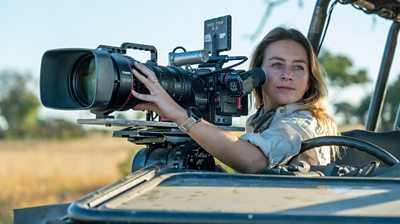
What can you tell us about the series?/ What is the series about?
Equipped with state-of-the-art camera technology and with the support of highly skilled trackers – the Big Cat’s 24/7 camera team take you to the heart of the Okavango Delta and delve into the lives of its unique cat inhabitants like never before. Unlike other wildlife series, this isn’t about getting that one shot, that one piece of behaviour - it’s about following these cats’ daily lives - and it doesn’t just stop when the sun goes down. Filming deep into the night with thermal cameras and drones, that’s often when the real action begins. Be prepared for a rollercoaster ride, because in Africa’s last great Eden, quite literally anything is possible.
What made you want to be part of this series?
I’ve been lucky enough to film animals in some incredible locations around the world, but it’s always been for a limited amount of time and to capture very specific behaviours. What drew me to this series was the opportunity to follow the lives of individual cats for months at a time. Big Cats 24/7 is a dream project for me because there’s no storyboard, no script, just the freedom to live alongside big cats day and night and experience their incredible lives in the paradise that they call home.
Tell us about your personal passion for the big cats explored throughout the episodes
The more time you spend with animals as intelligent, skilled and adaptable as big cats, the more you start to appreciate how each and every individual has its own character. Some can be shy, some are bold, some brave or funny - all these personality traits emerge over time. They become so much more than a subject for a documentary; they become a characterful individual that you develop a deep connection with.
Do you have a favourite big cat from the series and why?
Cheetahs are the underdogs of the big cat world; they are at the bottom of the pecking order. They are quite literally ‘scaredy-cats’; constantly chased away from their kills, even by a single barking baboon. They’ve got so many challenges to face that you just can’t help rooting for them. There are now fewer than 7000 cheetahs left in the wild, and the species is recognised as ‘endangered’ by the IUCN; yet 1,700 cheetahs call Botswana their home. Against the odds, they eek out a life here in the pockets between the lion prides and despite all of the challenges that they face, they still manage to survive and thrive with arguably the most swagger and pizazz of all of the big cats.
Which is your favourite big cat story from the series?
You naturally end up connecting most with the animal characters that you can relate to. For me, none more so than Pobe, a female cheetah who became a star of the series. With a home territory overlapping the Xudum lion pride’s, Pobe must work so much harder just to survive. And as a lone agent, she can’t rely on the support system or back-up that comes from living in a coalition or a pride like her neighbours do. This became increasingly clear in the way that she moved through the landscape, constantly looking over her shoulder and hiding in the shadows. It also made her very hard to track. But despite living in such proximity to lions, she still managed to bring up a cub to adulthood (Neelo) and is capable of the most exquisite hunts.
Experiencing her struggles and successes throughout my time in the delta, I found myself thinking about her, even when we hadn’t seen her for weeks - that’s when you know you’ve truly connected with an animal. During those incredible, if fleeting, moments with her, it became clear why she’s known as Xudum Island’s most ‘streetwise’ cheetah.
Tell us a bit about your background, how did you get into wildlife filmmaking?
Perhaps unconventionally, my natural history filmmaking career started underwater. Being half Greek, I spent all my summers in the sea and fell in love with the natural world from the moment I could swim. It was only after I was given the opportunity to film above water on a Disney + series that I was introduced to long-lensing. Being able to observe animals’ lives from afar, without disturbing their natural behaviour gives you a unique glimpse into their most intimate moments. It is those secret minutes that are key to discovering an animal’s individual character and it’s what I love most about wildlife filmmaking.
What challenges did you face whilst filming this series?
One of the biggest challenges of filming ‘Big Cats 24/7’ is adapting to the rhythm of the cats’ lives. It goes from 0-100 (or 0-64mph if you’re following a cheetah) in a flash, so you have to be ready for quite literally anything at any given moment.
What was the most standout or memorable sequence for you in this series?
One of my most memorable sequences may not be the most epic in terms of footage, but it was an encounter that has really stuck with me. It had been weeks since we’d been able to find Pobe, or even so much as a cheetah track and so we decided to expand our search into new territory, south of Xudum Island. After 4 days of driving and constant scanning, we spotted a family of four cheetahs in the thickets; an extremely shy female known as ‘Lesego’ and her three nearly adult cubs.
I’d been worried that the sheer number of lions in the area meant that cheetahs no longer had a place there. Sadly fewer than 1 in 10 cubs survive past 2 months old, but here in front of us was a cheetah with three cubs, all of them surviving against the odds. Lesego and her cubs were proof that cheetahs are still managing to successfully live here, despite the lions and despite the constant challenges that are thrown at them every single day. She was my beacon of hope for female cheetahs like Pobe.
Did you learn anything new about Botswana and the big cats you filmed that you didn’t know before being involved in the series?
Before Big Cats 24/7, I had no idea how adaptable big cats had to be to survive in the Okavango Delta. It’s an environment that’s in a constant state of flux, and the cats here are always shifting their behaviours according to the seasons and landscapes.
I was amazed to see how they take these challenges head on, and even use them to their advantage. After a huge wildfire tore through Xudum Island and devasted the landscape, Cheetahs began to use the remaining areas of surviving scrub as cover before bursting out over vast burnt flood plains towards unsuspecting prey. The burn became the perfect hunting ground for the sprinters of the big cat world. When the flood later arrived and transformed the landscape once again, the same cheetahs morphed into swamp cats, wading through the water to reach their historic territories. Even lions were submerging themselves in flood water as cover to hunt lechwe.
What do you hope viewers will take away from watching Big Cats 24/7?
Whenever I talk to family or friends about ���˿��� natural history series, the feedback is often that the ‘making of’ section at the end of the episode is their favourite part. There’s a reason for that; we are all human and naturally relate to human emotions. This series is unique, because it combines those human emotions with extraordinary animal encounters. State of the art camera technology brings us closer than ever to these animals, delving deeper into their lives and allowing their personalities to emerge and develop over time. I’m hopeful that these cats, with their little quirks and complexities, will become household names – so that even if you live 5,000 miles away from the Okavango Delta, you’ll still be rooting for them.
Brad Bestelink (Creative Director The Natural History Film Unit, Botswana)
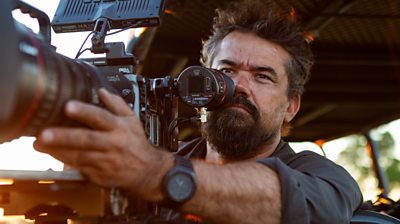
The Natural History film Unit is a Botswana registered, citizen owned independent production company founded in 2010 by Brad Bestelink and Andy Crawford. Born of Botswana, where wild animals are national assets and are to be protected and respected by all, the NHFU strives to make films that encourage people to appreciate and value wildlife. The NHFU has worked with all the major international broadcasters and is recognized for it’s unique approach towards wildlife programming. The NHFU has won a number of international awards, ranging from Best
Documentary Feature and Best Natural History Film, to awards for Best Story, Animal Behaviour and Cinematography.
What can you tell us about the series?/ What is the series about?
Big Cats 24/7 is a series that puts you in the vehicle in one of the last true wildernesses with some of the most dedicated passionate people who have a love and fascination of the big cats. You join them as they follow individual characters day and night on an incredible journey and live and witness the trials tribulations, the highs and lows of what it takes to be a big cat.
What made you want to be part of this series?
What made me want to be part of the series was the opportunity to be part of a committed crew, extend my time beyond what we normally do when filming big cats and to delve into a more comprehensive picture of their lives. To be able to follow individuals 24/7, day and night, just opens the opportunity for more understanding of the animals I know and love. Who wouldn’t want an opportunity to do that?
Tell us about your personal passion for the big cats explored throughout the episodes.
I have known the characters we film in big cat for years. Xudum since she was a cub, Pobe when she had Neelo as a cub, and the Xudum lions when they only had 12 in their pride. I have invested a lot of my time into all of them over the years, and to now have dedicated crews following them is a dream. It’s like having someone watching over and updating me on my extended family's progress. There is much personal satisfaction in knowing what is happening in the lives of subjects you care about.
Tell us a bit about your background, how did you get into wildlife filmmaking?
I was fortunate to have been born to the Okavango Delta, and from 4 days old it’s always been the most predominant influence on my life. From parents who pioneered photographic safaris here, my life was destined to be intertwined with it. I just wanted to be in the wilds and have the wild things be my focus, not tourists and people, but the animals. Photography enabled this at a young age, and filmmaking was a logical next step. Working on something more encompassing that would take years to complete, and something that provided more of a platform to share what I was seeing and experiencing was my goal. I started right after school at age 17, working for wildlife filmmakers and have never looked back. That was the start to something I hope never ends.
What challenges did you face whilst filming this series?
There were a few challenges in filming the series, mainly I am not used to having so many crews out at one time. Logistically it’s a bigger camp and many more people and therefore more responsibility. It helped having crew of my own that I had trained for years, but there were a few people who were not so familiar with our style of life. They adapted quickly, but that was always a worry. I also had difficulty not trying to get involved with all the cat characters, and to just focus on leopards, I felt I was missing seeing what everyone else was up too. The cats I mean.
Did you learn anything new about Botswana and the big cats you filmed that you didn’t know before being involved in the series?
You learn a lot every day you are with these big cats, but having such amazing coverage just increased that. Seeing lions catching catfish and lions submerging in water to hunt lechwe are absolute firsts. Some of these behaviours were so bizarre and unusual that they had never even considered them possible, let alone ever having filmed them before.
What do you believe is so captivating about this region?
The Okavango is the most captivating environment. It’s not only one of the greatest wildlife areas left on our planet, a rare oasis of life, but it is also forever changing, not just from year to year but season to season. The environment is constantly in flux and it means all the animals are too. This change affects the big cats especially so, and is what makes their lives so interesting. They adapt and change to the ebb and flow and this makes a heightened potential to see unusual animal behaviour. A filmmaker's dream.
Do you have a favourite big cat from the series and why?
Xudum the resident female leopard in the area is my favourite character. Leopards are the most beautiful, most elusive, most adaptable and the most solitary cats. Following Xudum has been like having a one on one personal relationship with her. I have also known her since she was a cub and have followed her progress, but to now see her as an adult; to invest dedicated time with her while she is starting a family, and being on this amazing journey with her, makes the experience that much more poignant for me. I have a special affection towards leopards anyway, but my focus being Xudum made it that much more profound for me.
What do you hope viewers will take away from watching Big Cats 24/7?
I hope that people can get to see the wonderfully complexed and beautiful lives these wild big cats have. Fall in love with them and place a massive imperative to making sure that these wild places are protected for them to continue to exist.
Few places are left where these cats can just live wild and be their iconic selves, and if we were to lose this I think we would be losing part of our humanity. I feel that they are the shining lights that symbolize and highlight our ability as a species, and if we can’t protect them we will not be able to even protect ourselves.
Tom Jarvis (Executive Producer)

What can you tell us about the series?/ What is the series about?
Big Cats 24/7 is a brand-new wildlife documentary series that follows the dramatic lives of lions, leopards, and cheetahs in the Okavango Delta in Botswana. The ambition of the show is to transport the audience to one of Africa’s last wildernesses, where a team of wildlife cinematographers are following individual big cats around the clock, capturing their behaviour day and night.
We filmed the six-part series over two seasonal shooting blocks, so we could be present at the times the landscape experiences change: from a punishing drought and wildfire, through to the arrival of a life-giving flood. This seismic shift in the environment is a major catalyst for change in the cat’s behaviour; some predators suddenly face increased competition for resources, others experience a tighter time frame to find a mate, and there are those that must navigate greater challenges as they try and rear the next generation… It really is a wild place, where really anything (and literally everything) can happen.
What’s exciting is the series is packed with unique behaviours and never-before-seen animal interactions. This was made possible to capture by a complex rolling shift pattern for the cinematographers, and due to the revolution, that has taken place in recent years in night-time filming technologies. Even experts that have been filming in the area for decades were capturing moments with the cats that even they had never witnessed before. For example, a hungry lioness at night desperately trying to grab a giant catfish from a drying out pool, a young male cheetah traversing deep water and then using it as cover to ambush his prey; and intimate footage of three-day old leopard cubs exploring the safety of their den and being cared for by their exhausted mum.
What I love about this series is it takes you to completely other world; we invite the viewer to go on the journey with our wildlife cinematographers, their whole mission is to get under the skin of the animals they are following, and they stick with them day and night. It feels truly immersive, and means we can tell longitudinal and personal stories about our cats in a way that feels new and unique.
It’s also a great privilege and incredibly humbling to get to spend so much time with big cats in the wild; you get to know them as individuals, understand their personalities and you cannot help but to fall in love with them. Even after being in camp just a few days, you find the whole crew are obsessed with the soap opera that is taking place around us. We are all immediately drawn into the cats’ world, curious to decode the meaning of their behaviours, and compelled to see them overcome their struggles, their dramas, and their stakes.
How long did it take to film?
The principal photography for the series took place over a six-month period (June-November 2023). This was planned as this is the time the landscape experiences enormous change.
The environment in June starts off dry and then the annual flood arrives… Trillian’s of litres of rainwater (from the highlands of Angola) flood the delta, bringing in animals from miles around, including thousands of cape buffalo that move through the area. These herds are a valuable food source for the lions but they can be highly aggressive, and weighing nearly a tonne they are also incredibly dangerous for all our cats. The flood water means there is also less available land for cats to move through, that means they are often on top of each other, jostling for prime real estate.
By October the place is experiencing the dry season – and as the temperature rises the heat is turned up too for all our cat characters. At this point during filming, the lion pride was raising an enormous number of cubs, the total number of cats in the pride had now reached over forty individuals but with more mouths to feed, there’s more competition and more pressure on the new mums rearing this next generation.
Across the series, we see that our cat’s ability to adapt to environmental change impacts their success. At times there are hard-earned wins but there is also gut-wrenching moments of loss witnessed too.
How did you chose which country to film and which big cats to focus on for this series?
Visible from space, the Okavango is the world’s largest in land delta. A combination of marshland and seasonal flood plains, it is rich in biodiversity and is often described as one of Africa’s last wildernesses. It certainly delivers on that. There is very little human activity in the area and that meant there was just us working in 150 square miles of bush, so we had the privilege of having the cats all to ourselves.
The location was selected as we wanted a place where we could capture footage of big cats living free from human disturbance. ���˿��� Studios, Natural History Unit had worked with Brad Bestelink and NHFU Botswana on previous projects, and this opportunity felt like an exciting one to collaborate on. Brad had recently designed and built a bespoke new filming camp right in the heart of big cat territory. We focussed initially our effort on following the cats that were known, but as our filming progressed it was thrilling for everyone to learn more about some of the other resident big cats.
Which big cat from the series was the hardest to film and why?
What you’ll see in the series is that cheetahs are by far the most elusive big cats in the delta, and the team do an incredible job of locating them.
But following leopards and telling their story is also deeply challenging, these cats are incredibly hard to find and harder still to stick with… This is because they are intelligent, highly secretive and at times behave like actual ninjas – vanishing before your very eyes. They tend to move around in low light and the pattern on their fur makes them often hard to spot. In the heat of day, they can hide for long periods in the long grass or conceal themselves in places like warthog burrows. We would often back off to give an individual space, just to discover a few hours later that it had given us the slip and then our search would begin again.
The other thing is that leopards are highly adaptable; possessing short legs and a long tail means they are built for arboreal life. That means you can be driving around gathering the clues they have left behind on the ground and in fact, they might be perched high up in a tree watching you the whole time! In a way, I like to think of them as living in an almost three-dimensional space, able to move off the ground with ease and to jump effortlessly through the branches of trees. It always pays off to look up when you are travelling through the bush!
The leopard we wanted to follow was a five-year-old female called Xudum. She has an incredible presence and after spending time with her you cannot help but fall in love with her. Her home range is close to camp and she can often be found right under Brad’s house! Brad has known her since she was a cub, has watched her grow up and it was exciting for us across the series to see her develop a new and ambitious hunting technique, see off rival leopards and become a new mum to two adorable cubs...
What challenges did you face whilst filming this series?
The ambition of the series felt enormous, we were producing a new format that had to deliver on new tech, new talent, and new behaviour… and we had to make six episodes in just over twelve months! The first thing was to make sure we had a good team and personally I was grateful to be working with fellow Executive Producer Roger Webb, and Series Producer Rowan Crawford. Previously, we three had worked together on the ���˿���’s Natural World strand, where we had made programmes like this but never a series on this scale. We were then joined by a talented production team and worked closely with the ���˿��� and PBS Commissioning teams throughout production.
Aside from the challenge of getting to know our growing cast of cat characters, one of the biggest difficulties the team faced was when filming camp was nearly burnt down by an unprecedented wildfire in the early weeks of filming. It was one of the largest and most destructive burns in nearly a decade and was a major blow to filming plans, completely wiping out a large swathe of the filming location and significantly disrupting the cat behaviour the team had expected to film.
However, the fire provided an entirely new set of problems and possibilities for our big cats. How would they all cope in this changed landscape? What unfolds is fascinating: the lion pride’s territory is exposed to intruders when all the dominant pride male’s scent marks are wiped out by the burn. Our key leopard character Xudum, must adapt to catch a meal: without the vital ground cover to keep her hidden to successfully ambush her prey, Xudum takes to the trees and shows viewers what Okavango leopards are famous for – ‘tree jumping’; launching an aerial assault to catch an impala. Meanwhile, the cheetah benefit from the landscape being more open, allowing Pobe, the resident female, to use her speed to chase down prey in newly cleared expanses of dry floodplain. It’s an illuminating transformation of the environment and it provided incredible cat behaviour and story in the aftermath.
What was the most standout or memorable sequence for you in this series?
Episode one starts with a bang – it is packed with unique behaviour. What is standout for me is this is where we first get to meet, understand and cannot help but to sympathise with three females in the Xudum pride who have recently become mothers to a group of adorable young cubs. These females are described as the engine room of the pride and are called Nosi, Mmakgosi and Maghogo. At this time of year as there is little food around and it’s a colossal challenge for them to provide enough meat to feed their growing cubs. The cubs are incredibly cute – especially a boisterous young boy called Mathata but they all at risk. The first two years of a lion’s life are its most vulnerable, only 20% of cubs make it to adulthood. It’s down to the females to rear the next generation and in this episode we and we see how they work together, take huge risks and deploy inventive strategies to ensure they provide for them.
A personal stand out moment for me was Xudum leopard’s first romance. I was lucky to enough to be filming Brad as he was following Xudum when she was in season and looking for love. What played out seemed to be a very complex mating strategy indeed. In a matter of a couple of hours, we had followed Xudum all over the delta as her date with one male leopard was interrupted by not one, but two furious angry lions and also an aggressive male leopard who did not take kindly to her and partner mating in his territory! Brad is able to keep up with the drama but says it’s one of the most chaotic mornings he has had for years.
What do you think Gordon, Anna, Vianet, Brad and their teams bring to the series?
The talent of our wildlife cinematographers is outstanding, they are all incredibly passionate about filming, deeply committed to wildlife conservation and fantastic at working as a team to bring the stories of the cats to screen. Each member of the cast has advanced technical capabilities and they needed every ounce of it whilst spending months on end in a filming truck. It’s quite a big ask – they were having to navigate challenging terrain, pre-empt big cat behaviour, and shoot footage to a high standard. The whole time we were filming them and asking them to interpret the animal behaviour unfolding in front of them. They all do a fantastic job and it feels like the result is a deep connection to the cats. Gordon has years of experience or working with big cats in the wild, Vianet has great knowledge of filming social animals, Anna loves her gadgets and night-time tech and Brad, and his team from the Natural History Film Unit in Botswana – Sets, Rea, Greg and Tristen – all live and breathe life in the African bush!
Are there any important conservation stories you wanted to get across this series?
While we don’t follow any singular conservation stories within the series, our fundamental aim is to highlight the extraordinariness of the Okavango Delta and the big cats that live there. This is a haven for wildlife, and a place where big cats are thriving – but that is not the case across Africa, or the world. Globally, largely due to habitat loss, human/wildlife conflict, and poaching, lions, leopards and cheetah are all in decline. All three species are listed as vulnerable on the IUCN Red List. There are only around 7000 cheetahs left in the wild, and in some parts of Africa lion populations have fallen by up to 60%. The aim with this series is for people to really connect with individual big cat characters, and in doing so develop in interest and passion for the wellbeing and future in their species in the wild.
Which is your favourite big cat story from the series?
Some stories are longitudinal, like the story of Xudum the female leopard which runs across the whole series and has to be up there as one of my absolute favourites. It was incredible to be able to follow a single leopard across six months, really develop her as an individual character, and root for her to succeed. We couldn’t have made the story of what happens to her up: young female leopard learns the ropes of survival in the Okavango Delta, adapting to whatever is thrown at her; learns to jump out of trees to catch her food; fights neighbouring female in bid to find a mate; finds mate…but he’s on another male’s turf, upsetting the dominant male in the area; has two cubs, but struggles to feed herself and them; then the dominant male finds her den… and she is forced to fight in an attempt to keep them alive. The stakes for her and her family couldn’t be higher.
Another compelling story: the lost cub, took place in just one night. The team follow an inexperienced lion mum Matho and her three-month-old cubs. Matho is scared by an angry elephant and leaves one of her cubs behind. We followed it over a 16-hour period as it narrowly avoided being eaten by jackals but after a tense all-nighter from Gordon to find out the cubs fate.
What do you hope viewers will take away from watching Big Cats 24/7?
To be get to film big cats in the Okavango Delta genuinely feels like winning the lottery. You are in an incredibly wild place with a group of iconic and majestic animals and life is defined by their pace, their rhythm, and their rules. As a guest in their world, you experience that every day is different and it is my hope that if you watch the series, you are given a deeper dive in to their lives and what they are facing.
Personally, I find their stories endlessness fascinating but I hope that by putting the spot-light on them in this way viewers will also be drawn to care about them and perhaps will think about their future in Africa. Unfortunately, big cats globally are on the decline and we need to protect them and their habitat. I hope viewers watching will see that yes, big cats are indeed powerful predators, but they are also compassionate, sensitive and highly adaptable. They have a rightful place on our planet and if we can understand them better, we are
Rowan Crawford (Series Producer)

What can you tell us about the series?/ What is the series about?
Big Cats 24/7 is a deep dive into the lives of the big cats – lions, leopards and cheetahs – living in the south west corner of the Okavango Delta in Botswana. We follow individual big cats, day and night, to really get to know their unique characters and the story of their lives. The series is a combination of blue-chip natural history footage, and ‘in the moment’ observational documentary – as well as showing viewers the lives of the big cats, we are also following the cinematographers who are capturing the amazing footage of them.
They are our primary storytellers, and it’s through their experiences and relationships with the cats that the stories unfold. It’s a truly immersive series that invites our viewers to go on the journey with our onscreen storytellers to really get under the skin of the cats we’re following.
What’s really cool about the series overall is that we have both closed and open narratives, by which I mean we have stories that resolve in a single episode, and others that run across multiple episodes – much like a soap opera. It’s a really engaging and entertaining way to package natural history. We haven’t compromised at all on the specialist factual content, just found a different way to serve it up. All the while maintaining our focus on the cats and their stories first; the story of our human characters second.
How long did it take to film?
The series was filmed across 6 months – roughly June to November, 2023. We had two principal 7 week filming blocks with the whole team on location, and then smaller groups in the field following the action for the rest of the time.
How did you chose which country to film and which big cats to focus on for this series?
The Okavango Delta is one of Africa’s last truly wild places. Tourism has a relatively small footprint in the area, and the big cats that live there are largely undisturbed – or filmed – by humans. This was a major factor in choosing this location – it’s given us insights into truly ‘wild’ big cat behaviour, even allowing us to witness and film some things that have rarely, or never been captured before.
For example, lions fishing for catfish at night, and climbing trees to steal food from leopards; cheetahs travelling through deep water; 3 day old leopard cubs. It’s also an incredibly dynamic landscape, that changes dramatically throughout the year, from drought and wildfires to life giving flood. This provides an amazing back drop to our cat’s stories, with the changing environment being a constant catalyst for change in the cats lives.
Which big cat from the series was the hardest to film and why?
Cheetahs were by far the hardest species for us to film. They are extremely elusive, constantly on the move, and experts at staying hidden! Particularly in areas where there is lots of competition from larger predators, like leopards and lions, which was very the much the case where we were filming. The area was packed with lions – by the end of the series we had approximately 40 lions in the pride – and cheetahs were quite sensibly doing their best to steer well clear of our location…which made them incredibly difficult to follow!
What challenges did you face whilst filming this series?
The primary challenge we faced was getting to know our incredible cast of cat characters. There were a lot of them, and not always easy to keep track off in an area covering 150 square miles! Some of them were known to the local team we joined up with, but some were entirely new to us all, so it took time to follow and understand them enough to be able to build them as characters and understand the parts they each played in the big cat ecosystem out there.
The second big challenge was that our camp was nearly burnt down by a huge wildfire in the early weeks of filming. This was a major blow to our filming plans, completely wiping out a large swathe of our filming location and significantly disrupting the cat behaviour we had expected to see and film at that time of year. It was also extremely traumatic for the whole team, with everyone running on adrenaline for days afterwards. However, it provided an entirely new set of challenges and possibilities for the big cats we were following. How would they all cope in this changed landscape?
We saw our pride’s territory exposed to intruders when all the dominant pride male’s scent marks were wiped out by the fire. Our key leopard character had to adapt to catch a meal: without the vital ground cover to keep her hidden and successfully ambush her prey she took to the trees and showed us what Okavango leopards are famous for – ‘tree jumping’ onto prey below. Meanwhile our cheetah benefited from the landscape being opened up, allowing her to use her speed to catch prey in newly cleared expanses of dry floodplain. It was a fascinating transformation of the environment, and our big cats, and whilst wholly unpleasant to experience at the time, everyone was okay and it provided incredible cat behaviour and story in the aftermath.
What was the most standout or memorable sequence for you in this series?
Episode 5, when Matho the lionesses comes back for her lost cub; it brings a tear to my eye every time I watch it! Matho accidently leaves one of her three cubs behind after a run in with some elephants in the middle of the night. The cub is alone for more than 24 hours, and everyone is loosing all hope that Matho is going to come back for it…including Gordon. What I love most about it this sequence is that it’s a great example of the narratives we are able to capture and stories we can tell by following these cats 24 hours a day.
So often in wildlife shows you lose an individual you have been following and never know what happened to it. But in this series, because we really do follow the cats day and night, handing over from cinematographer to cinematographer, we are able to capture these incredible rollercoaster moments, that keep you gripped as a viewer, and as a film maker. This series proves there is nothing more dramatic than real life!
What do you think Gordon, Anna, Vianet, Brad and their teams bring to the series?
The ensemble cast of onscreen characters is really great in this series because if feels like they are all very different and very authentic in what they bring to the show. Gordon has years of experience filming big cats, particularly lions, bringing a depth of knowledge that is pivotal to tap into. He also has vast experience of observational documentary and expedition type filming, which this series very much is. Add to that the fact that he was part of the camera team on the original
Big Cat Diary series, he’s the perfect fit for this show! Vianet has incredible knowledge of filming social animals, particularly gorillas and elephants. His insights into the family dynamic of our lion pride – the only social big cats – are both insightful and entirely human, inviting the audience to connect with the cats in his own uniquely personable way. Anna brings a fresh face and great new energy to our lineup. She’s very much an up-and-coming wildlife cinematographer – and onscreen talent – with an incredible technical skill set.
She’s also mad about cheetahs – a species she had always wanted to see up close in the wild before she joined this project, and is now very much a reality for her. Meanwhile Brad, and his team from the Natural History Film Unit in Botswana – Sets, Rea, Greg and Tristen – all live and breathe life in the bush! Brad has lived in the Okavango Delta since he was 4 days old. He knows the area we are working in like the back of his hand, and when it comes to leopards, his field craft and knowledge is second to none. His set up out there is also incredible. A bespoke film camp, entirely created for the purpose of filming and following the wildlife in the area. His passion for his home country, and specifically the Okavango Delta, is infectious, and his team of cinematographers share this through and through.
Are there any important conservation stories you wanted to get across this series?
While we don’t follow any singular conservation stories within the series, our fundamental aim is to highlight the extraordinariness of the Okavango Delta and the big cats that live there. This is a haven for wildlife, and a place where big cats are thriving – but that is not the case across Africa, or the world. Globally, largely due to habitat loss, human/wildlife conflict, and poaching, lions, leopards and cheetah are all in decline.
All three species are listed as vulnerable on the IUCN Red List. There are only around 7000 cheetah left in the wild, and in some parts of Africa lion populations have fallen by up to 60%. The aim with this series is for people to really connect with individual big cat characters, and in doing so develop in interest and passion for the wellbeing and future in their species in the wild.
Which is your favourite big cat story from the series?
This is an incredibly difficult question to answer – I love them all!! But if I may…I’m going to give two answers here:
The story of Xudum the female leopard that runs across the whole series has to be up there as one of my absolute favourites. It was incredible to be able to follow a single leopard across 6 months, really developing her as a individual character, and rooting for her to succeed. I couldn’t have made the story of what happens to her up it’s an absolute banger, and would sit happily in a soap like Eastenders!!
The other story that I really love is in episode 3 when we follow the sub-adult male lions, Colin and Nkgonne as they are pushed out of the pride. What I like about this narrative is that it’s a part of lion society and behaviour that would probably never appear in a landmark natural history series, but in a show like ours, we have the time and space, and the human storytellers, to really build the characters and follow the multiple beats of a story like this across an episode. It was fantastic to be able to shine a light on a detail like this – and gives the viewer an insight into lion behaviour and society that its rarely, if ever shown.
What do you hope viewers will take away from watching Big Cats 24/7?
After watching the series I hope viewers will have a greater understanding of the intricacies of big cat life – and the amazing haven the Okavango Delta in Botswana is for them. They are incredible animals, that lead fascinating lives, and the drama of their reality is endlessly captivating! But they are also facing many threats and their numbers are in decline. I hope this series will reignite people’s love and awareness of big cats, ultimately putting them in the spotlight, and ensuring we think carefully about how to look after them for the future. Africa without big cats is unthinkable. But if we don’t protect these animals, one day it could be a reality.
I hope viewers will also have a greater understanding of what it’s like to follow these animals from a human perspective. Filming wild animals day and night is not always easy. Days are long, and the cats are designed for these environments, whilst the humans aren’t. However, the connections and relationships that grow between the human storytellers and the cats they are following is hugely rewarding to watch.
It has allowed us to create a natural history series with a very different look and feel to other content out there at the moment, without compromising on the specialist factual detail you would expect from a ���˿��� 2 show. I hope this series will appeal not only to diehard natural history fans, but also viewers who may be new to the genre, and might find this type of show an easier way in.
